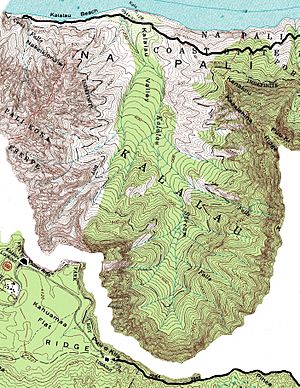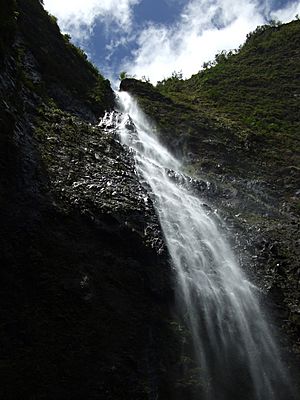Kalalau Valley facts for kids
The Kalalau Valley is located on the northwest side of the island of Kauaʻi in the state of Hawaiʻi. The valley is located in the Nā Pali Coast State Park and houses the Kalalau Beach. The Nā Pali Coast is rugged and is inaccessible to automobiles. The only legal ways to access the valley are by kayak or by hiking the Kalalau Trail.
The valley is surrounded by cliffs more than 2,000 feet (610 m) high. This valley's bottom is broad and relatively flat, with an accessible region about 2 miles (3.2 km) long and 0.5 miles (0.80 km) wide. The abundant sun and rain provides an ideal environment for flora and fauna. Many native Hawaiians lived in the valley into the 20th century, farming taro from a vast complex of terraced fields. Today, its designation as a state park forbids anyone from residing there.
Contents
Access to Kalalau Valley
Since the Nā Pali Coast is too steep for any motorized vehicles, all access to the valley is by boat or foot, except for emergency helicopter landings. Kayaks are a popular way of visiting the valley, although sea conditions can make this dangerous during the winter. Hiking and trail running the Kalalau Trail are also popular, but the trail is about 11 miles (18 km) long, quite strenuous for those not in good shape, and can be dangerous at parts for inexperienced people.
Access to the Kalalau Valley is controlled. A limited number of permits are sold for camping in Kalalau Valley every year by the Hawai'i Department of Land and Natural Resources (DLNR), although parking for campers is no longer allowed at the trail head. Instead, parking is now an exclusive privilege for day users of Ha'ena State Park, where the Kalalau trail head is located, and permitted Kalalau campers are provided no overnight parking whatsoever. Anyone wishing to hike or run beyond Hanakāpīʻai valley must have a permit for staying in Kalalau Valley overnight, even if their intention is to return the same day. A total of sixty overnight permits are issued for each night. Permits must generally be sought as early as 6 months in advance of travel.
Ecology
The valley is home to many rare species, including the endangered plant Dubautia kalalauensis which was named for the valley and is found nowhere else in the world. Other endemics include the endangered Schiedea attenuata., and previously unknown plant species have been discovered there.
Life in Kalalau Valley
The natural environment and relative isolation, despite the noise of constant helicopter traffic, are the major attractions of the valley. Legal campers stay outside the valley in the designated camping area within roughly 300 feet (91 m) of Kalalau beach. There is a small waterfall in this area that is used for bathing and washing dishes.
At one end of the beach is a stream that is also used for fresh water. All the streams are susceptible to contamination with leptospirosis, a bacterium that is transmitted from the urine of infected rodents.
Squatters
In spite of the efforts of the state of Hawaii, some people illegally hike the Kalalau Trail and camp and even live in the valley. Visitors who do not have a permit are occasionally issued citations that require a court appearance and a fine of up to $500 for a first offense.
Destruction of terraced gardens
The terraced gardens in the Kalalau Valley are threatened by the introduced, invasive trees which create underground root networks invading the rock walls. The trees then fall and topple the rock walls causing permanent damage. The origin of the trees is disputed.
Management of Kalalau Valley
The valley is a part of the Nā Pali Coast State Park and the DLNR is responsible for its maintenance and preservation.
See also
 In Spanish: Valle de Kalalau para niños
In Spanish: Valle de Kalalau para niños




